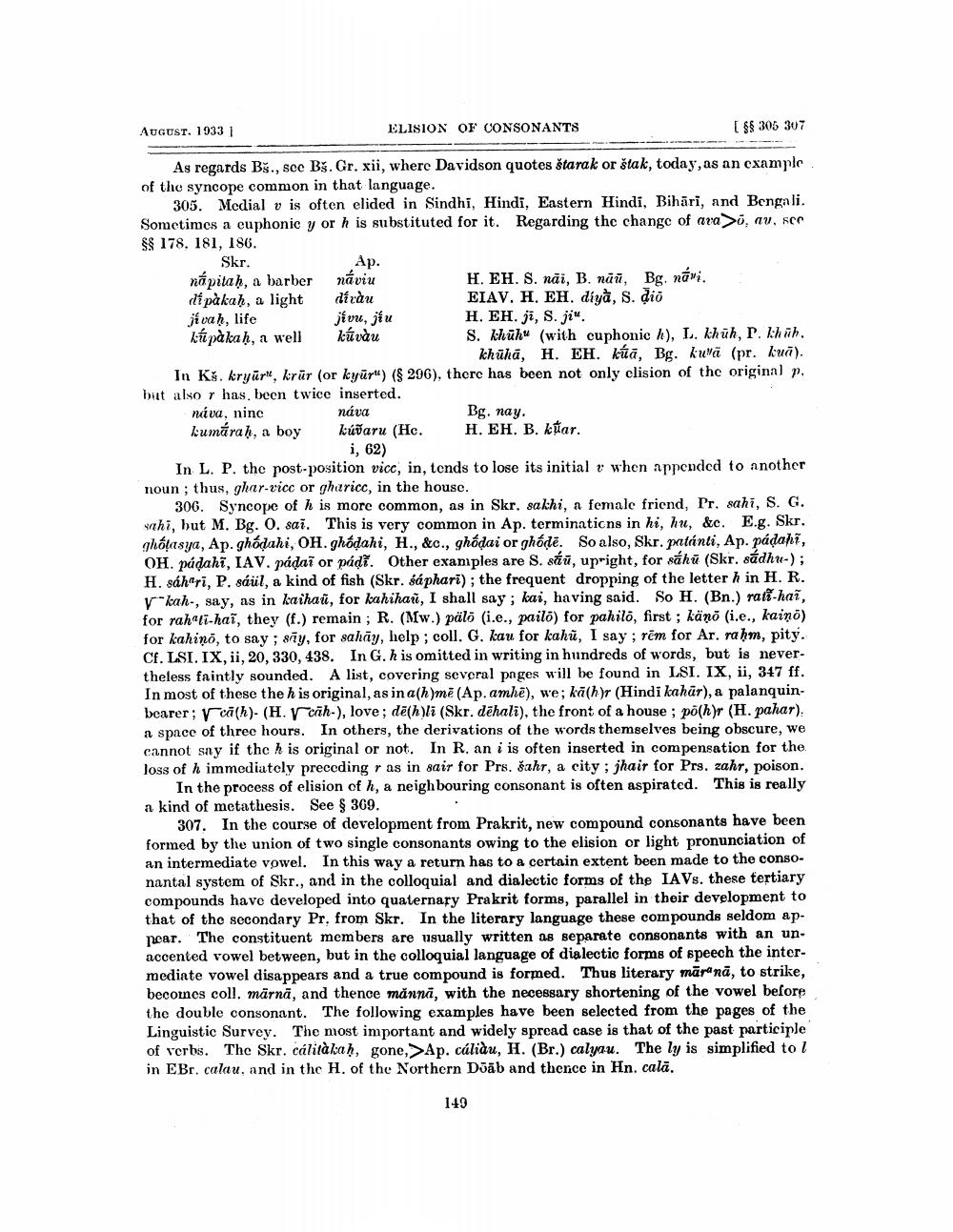________________
AUGUST, 1933
ELISION OF CONSONANTS
[$$ 305 307
As regards Bš., sec Bš. Gr. xii, where Davidson quotes štarak or štak, today, as an example of the syncope common in that language.
305. Medial v is often elided in Sindhi, Hindi, Eastern Hindi, Bihāri, and Bengali Sometimes a cuphonic y or h is substituted for it. Regarding the change of ava>, au, ser SS 178. 181, 186. Skr.
Ap. nápitaḥ, a barber náviu
H. EH. S. nãi, B, mini, Ba, nối. di pàkah, a light diràu
EIAV. H. EH. diyà, s. dio jivaḥ, life
jivu, jíu
H. EH. ji, S. jiu. kú på kah, a well kúvàu
S. khūhu (with cuphonic h), L. khūh, P. Khih.
khūhā, H. EH. kúa, Bg. kuva (pr. kuă). In Kš. kryūru, krür (or kyūr") ($ 296), there has been not only clision of the original p. but also r has been twice inserted. náva, nine
Bg. nay. kumárah, a boy kúðaru (Hc. H. EH, B. kúar.
i, 62) In L. P. the post-position vicc, in, tends to lose its initial when appended to another noun; thus, ghar-vicc or gharicc, in the house.
306. Syncope of h is more common, as in Skr. sakhi, a female friend, Pr. sahi, S. G. shi, but M. Bg. 0. sai. This is very common in Ap. terminations in hi, hue, &c. E.g. Skr. ghótasya, Ap.ghódahi, OH. ghốdahi, H., &c., ghodai or ghódë. So also, Skr. patánti, Ap. páďahi, OH. pádaki, IAV. pádai or pádi. Other examples are S. sáu, upright, for sáhū (Skr. sádhu-); H. sáhrri, P. sáül, a kind of fish (Skr. sáphari); the frequent dropping of the letter h in H. R. rokah., say, as in kaihaü, for kahihar, I shall say; kai, having said. So H. (Bn.) rati-hai, for rahati-hai, they (f.) remain ; R. (Mw.) pälö (i.e., pailö) for pahilo, first; käno (i.e., kaino) for kahino, to say; siy, for sahāy, help; coll. G. kau for kahū, I say ; rem for Ar. rahm, pity. Cf. LSI, IX, ii, 20.330, 438. In G. h is omitted in writing in hundreds of words, but is nevertheless faintly sounded. A list, covering several pages will be found in LSI. IX, ii, 347 ff. In most of these the h is original, as in a(h)mē (Ap. amhē), we; kā(h)r (Hindi kahār), a palanquinbearer; vca(h). (H. V ch-), love; dē(h)li (Skr. dēhali), the front of a house ; põ(h)r (H. pahar). a space of three hours. In others, the derivations of the words themselves being obscure, we cannot say if the h is original or not. In R. an i is often inserted in compensation for the loss of h immediately preceding r as in sair for Prs. šahr, a city; jhair for Prs, zahr, poison.
In the process of elision of h, a neighbouring consonant is often aspirated. This is really a kind of metathesis. See $ 369.
307. In the course of development from Prakrit, new compound consonants have been formed by the union of two single consonants owing to the elision or light pronunciation of an intermediate vowel. In this way a return has to a certain extent been made to the consonantal system of Skr., and in the colloquial and dialectic forms of the IAVs. these tertiary compounds have developed into quaternary Prakrit forms, parallel in their development to that of the secondary Pr, from Skr. In the literary language these compounds seldom apnear. The constituent members are usually written as separate consonants with an un. accented vowel between, but in the colloquial language of dialectic forms of speech the intermediate vowel disappears and a true compound is formed. Thus literary marana, to strike, becomes coll. mārnā, and thence männā, with the necessary shortening of the vowel before the double consonant. The following examples have been selected from the pages of the Linguistic Survey. The most important and widely spread case is that of the past participle of verbs. The Skr. cálitàkaḥ, gone,>Ap. cálidu, H. (Br.) calyau. The ly is simplified to l in EBr. calau, and in the H. of the Northern Djāb and thence in Hn. calā.
149




